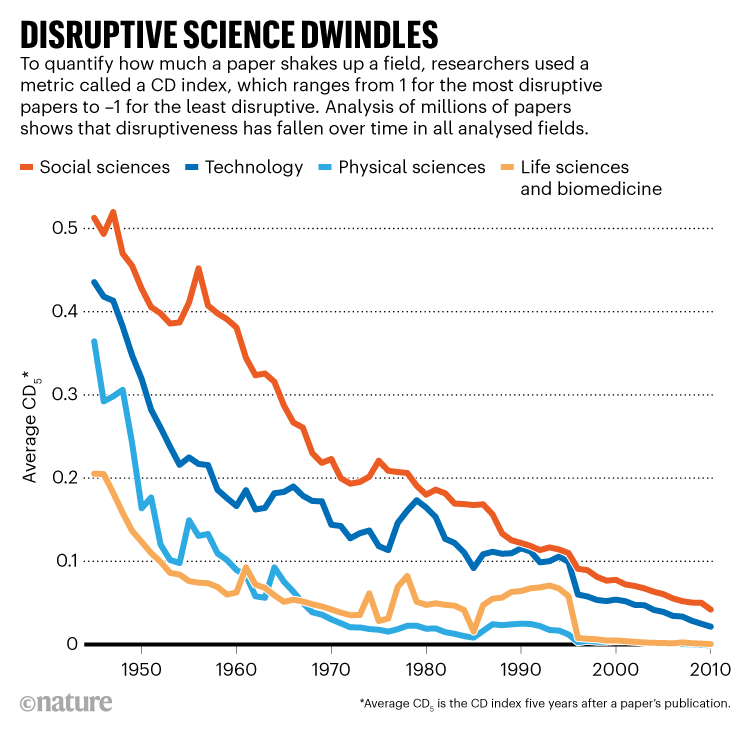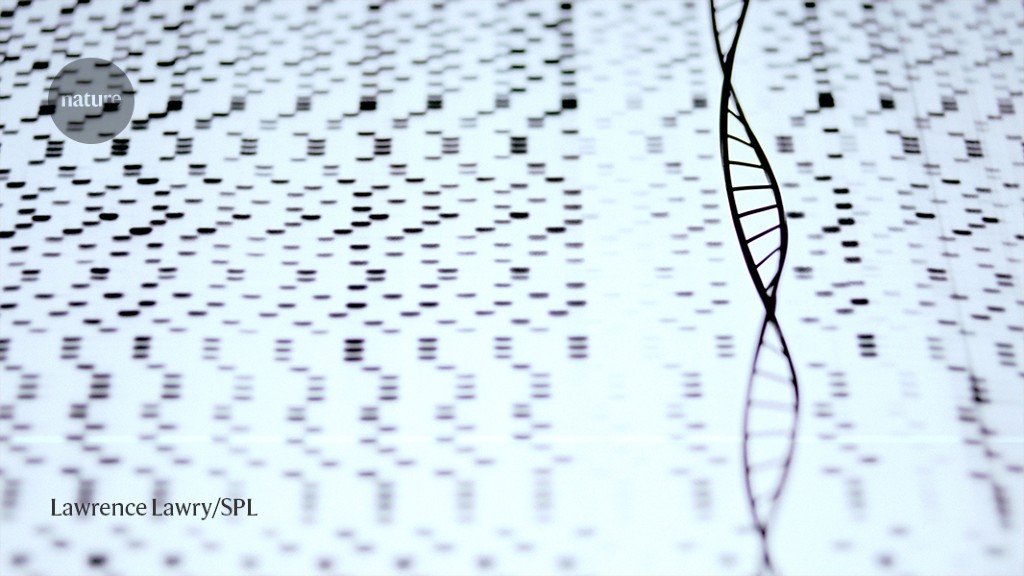
The proportion of disruptive scientific papers, such as the 1953 description of DNA’s double-helix structure, has fallen since the mid-1940s.Credit: Lawrence Lawry/SPL
The number of science and technology research papers published has skyrocketed over the past few decades — but the ‘disruptiveness’ of those papers has dropped, according to an analysis of how radically papers depart from the previous literature1.
Data from millions of manuscripts show that, compared with the mid-twentieth century, research done in the 2000s was much more likely to incrementally push science forward than to veer off in a new direction and render previous work obsolete. Analysis of patents from 1976 to 2010 showed the same trend.
“The data suggest something is changing,” says Russell Funk, a sociologist at the University of Minnesota in Minneapolis and a co-author of the analysis, which was published on 4 January in Nature. “You don’t have quite the same intensity of breakthrough discoveries you once had.”
Telltale citations
The authors reasoned that if a study was highly disruptive, subsequent research would be less likely to cite the study’s references, and instead cite the study itself. Using the citation data from 45 million manuscripts and 3.9 million patents, the researchers calculated a measure of disruptiveness, called the ‘CD index’, in which values ranged from –1 for the least disruptive work to 1 for the most disruptive.
The average CD index declined by more than 90% between 1945 and 2010 for research manuscripts (see ‘Disruptive science dwindles’), and by more than 78% from 1980 to 2010 for patents. Disruptiveness declined in all of the analysed research fields and patent types, even when factoring in potential differences in factors such as citation practices.

Source: Ref. 1
The authors also analysed the most common verbs used in manuscripts and found that whereas research in the 1950s was more likely to use words evoking creation or discovery such as ‘produce’ or ‘determine’, that done in the 2010s was more likely to refer to incremental progress, using terms such as ‘improve’ or ‘enhance’.
“It’s great to see this [phenomenon] documented in such a meticulous manner,” says Dashun Wang, a computational social scientist at Northwestern University in Evanston, Illinois, who studies disruptiveness in science. “They look at this in 100 different ways, and I find it very convincing overall.”
Other research2 has suggested that scientific innovation has slowed in recent decades, too, says Yian Yin, also a computational social scientist at Northwestern. But this study offers a “new start to a data-driven way to investigate how science changes”, he adds.
Disruptiveness is not inherently good, and incremental science is not necessarily bad, says Wang. The first direct observation of gravitational waves, for example, was both revolutionary and the product of incremental science, he says.
The ideal is a healthy mix of incremental and disruptive research, says John Walsh, a specialist in science and technology policy at the Georgia Institute of Technology in Atlanta. “In a world where we’re concerned with the validity of findings, it might be a good thing to have more replication and reproduction,” he says.
Why the slide?
It is important to understand the reasons for the drastic changes, Walsh says. The trend might stem in part from changes in the scientific enterprise. For example, there are now many more researchers than in the 1940s, which has created a more competitive environment and raised the stakes to publish research and seek patents. That, in turn, has changed the incentives for how researchers go about their work. Large research teams, for example, have become more common, and Wang and his colleagues have found3 that big teams are more likely to produce incremental than disruptive science.
Finding an explanation for the decline won’t be easy, Walsh says. Although the proportion of disruptive research dropped significantly between 1945 and 2010, the number of highly disruptive studies has remained about the same. The rate of decline is also puzzling: CD indices fell steeply from 1945 to 1970, then more gradually from the late 1990s to 2010. “Whatever explanation you have for disruptiveness dropping off, you need to also make sense of it levelling off” in the 2000s, he says.
